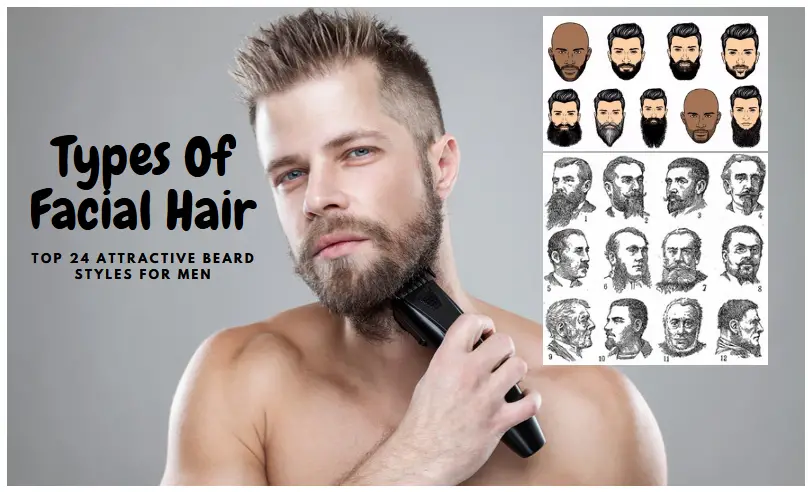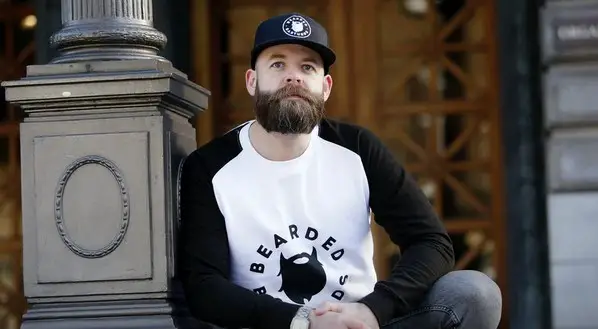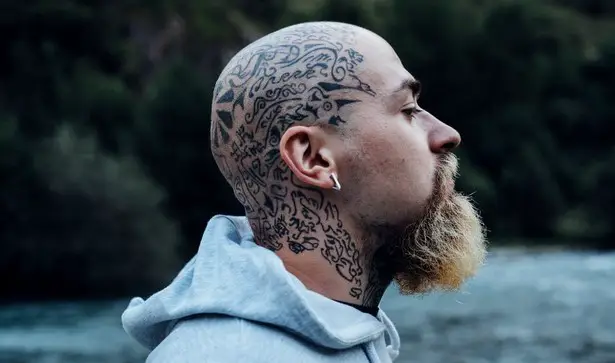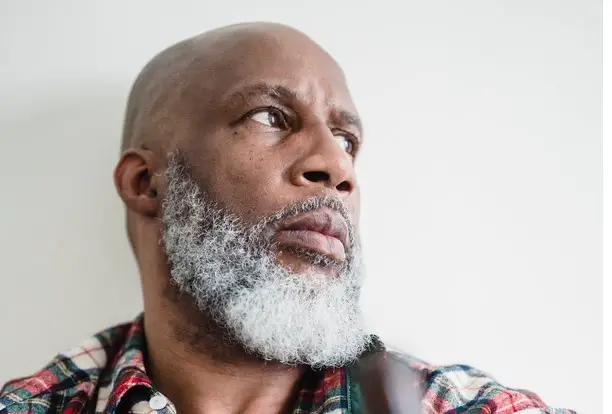Dive into the fascinating world of beard growth patterns and stages as we unravel the mysteries behind your unique scruff.
Beard growth is a natural process that many men experience. It involves facial hair appearing and getting thicker over time. I will talk about how beards grow, their different patterns, and the five stages of beard growth: stubble, patchy phase, short beard, growing out stage, and full beard glory.
Usually, beards grow about half an inch each month.
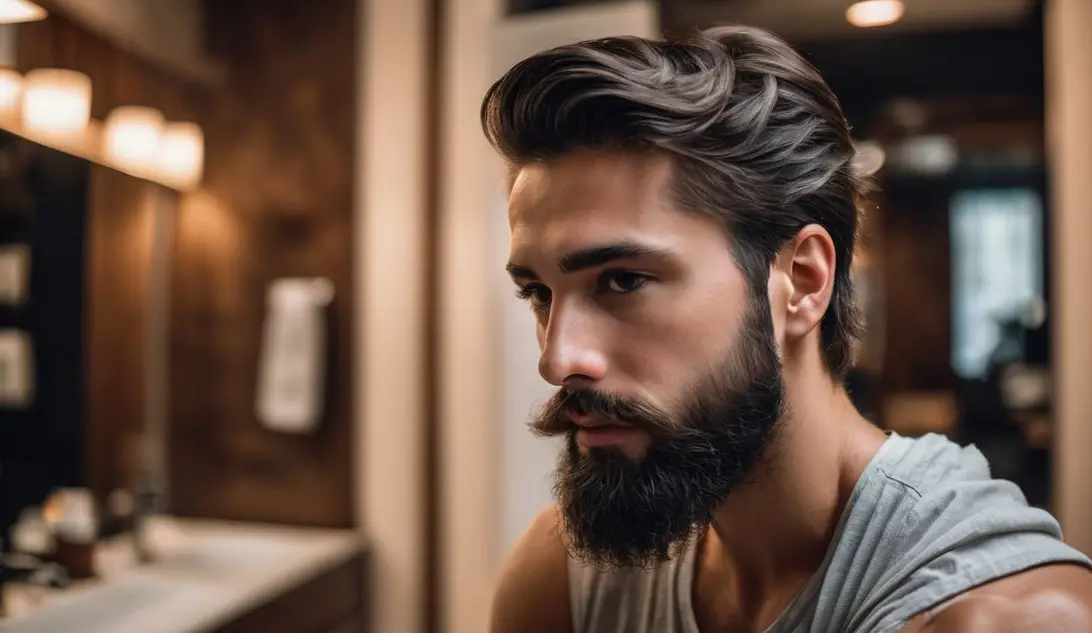
Our family’s traits play a big part in our own beard growth. If your father or grandfather could sport a thick beard, there’s a good chance you can also experience plentiful facial hair growth. Hormones like testosterone also affect how much beard you get.
Plus, taking care of yourself by eating well and sleeping enough helps your beard look its best.
As boys transition into their teenage years of 13 to 16, they start noticing new hair sprouting around their mouths, gradually permeating the rest of their faces. As men diligently use oils and grooming tools to care for their beards throughout the growth cycle, they can cultivate solid and healthy beards over time.
Knowledge of these intricacies can assist men in understanding what to anticipate as they grow a beard. Continue reading to familiarize yourself more about each growth cycle phase and various strategies to fortify your facial hair!
Key Takeaways
- Beard growth starts during the teen years and is influenced by genetics and hormones like testosterone. The amount of facial hair and where it grows can differ for everyone.
- There are five stages of beard growth: stubble, patchy, short beard, growth and grooming, and full-bearded glory. Each stage requires different care to keep the beard healthy.
- A man’s diet, sleep schedule, hormone levels, and how he cares for his beard affect how well his facial hair will grow.
- Some men might have patchy beards because of less blood flow to their faces or differences in their skin health. Follicles may not all grow hair at the same time.
- To get a great-looking beard that’s thick and even, it helps to trim regularly. This makes sure your hairs all grow out well together without some being too long or too short.
Understanding Beard Growth
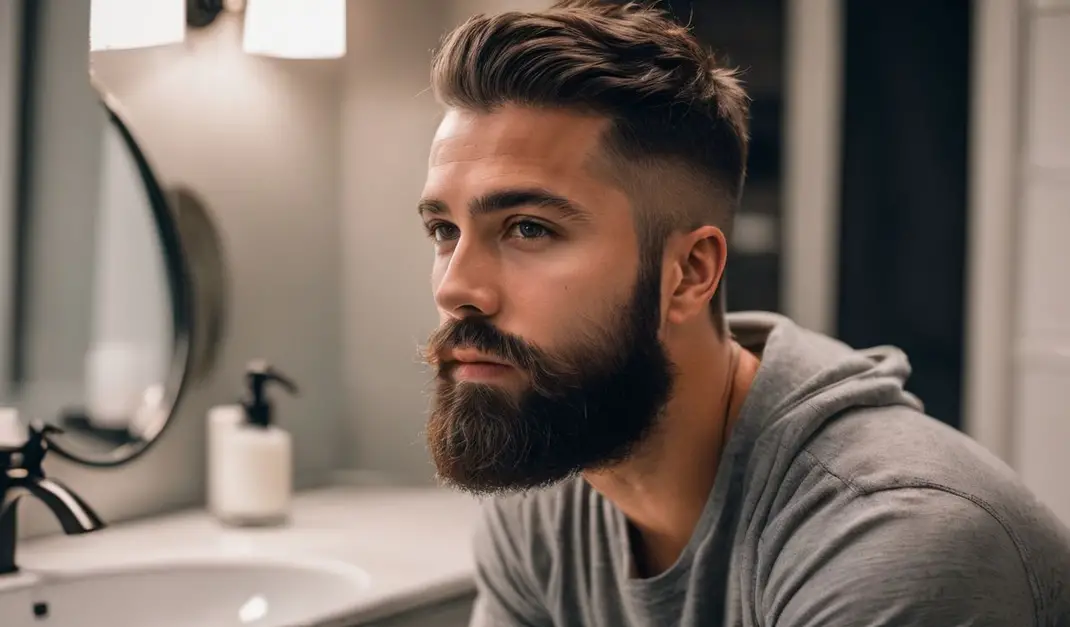
Facial hair typically starts to grow during puberty, although the timing can vary for each individual. The growth and thickness of a beard are primarily determined by genetics and hormone levels, with some men experiencing patchy or uneven growth patterns.
Additionally, the direction in which beard hair grows can vary from person to person.
https://www.youtube.com/watch?v=6-7F87r4uTQ
When and where does facial hair start growing?
Boys start seeing facial hair in their teens, ages 13 to 16. This happens because of male hormones that wake up during puberty. Hairs pop up first on the upper lip, then move on to places like sideburns and chin before finally reaching the cheeks.
Each boy has his own pattern for how his beard will come in. It’s like a map that shows where and how fast his hair will grow on his face. These patterns are decided by genes, which kids get from their parents, so a son’s beard might look like his dad’s or grandpa’s.
The role of genetics in beard growth
My beard might look a lot like my dad’s, and that’s because genes have a big part in how it grows. If your father has a thick and full beard, you may sport the same facial hair.
It’s not just about whether you can grow one; genetics also shape how fast it comes in and where it appears on your face.
Some folks inherit patchy spots, while others get that even cover. Remember, though, that things like testosterone matter, too. Higher testosterone often means more facial hair. But remember, no two people are exactly alike—even with beards! Now, let’s talk about those different beard growth patterns I see daily.
Explaining Beard Growth Patterns
Understanding the patterns of beard growth is essential for achieving your desired look. We’ll delve into why some men have patchy beards and how the direction of beard hair growth can affect your overall appearance.
https://www.youtube.com/watch?v=pdoUproXqvM
Why some men have patchy beards
Some guys have spots in their beards where hair doesn’t grow much. This can happen for a few reasons. One big reason is genetics, which means it runs in the family.
If your dad or grandpa had areas with less hair on their face, you might, too. Also, the health of your skin and how well blood flows to your face matter. Good blood flow helps those beard hairs come in thick! Sometimes hormones also play a part; not enough testosterone might make it hard to grow a full beard.
Your body also has different kinds of hair. The stuff on your head isn’t the same as what grows on your chin and cheeks. Some hairs are thin and soft, while others are thicker and stiffer; this mix can make some parts look fuller.
Plus, each little hole in your skin where hair grows – called follicles – could be doing its own thing at any time, which adds to why beards look patchy sometimes.
Now, let’s talk about which way those whiskers like to go when they do decide to show up!
The direction of beard hair growth
Understanding the direction of beard hair growth is essential for grooming and maintenance. Beard hairs do not all grow in the same direction, which can affect how your beard looks and feels.
The natural pattern of hair growth on different face parts varies, leading to areas where hair grows upward while others grow downward or sideways. This variation in growth direction determines how you should style and trim your beard to achieve an even and well-groomed appearance.
Properly comprehending this aspect allows you to adapt your grooming routine according to the unique growth pattern of your facial hair, ensuring a neat look.
The Stages of Beard Growth
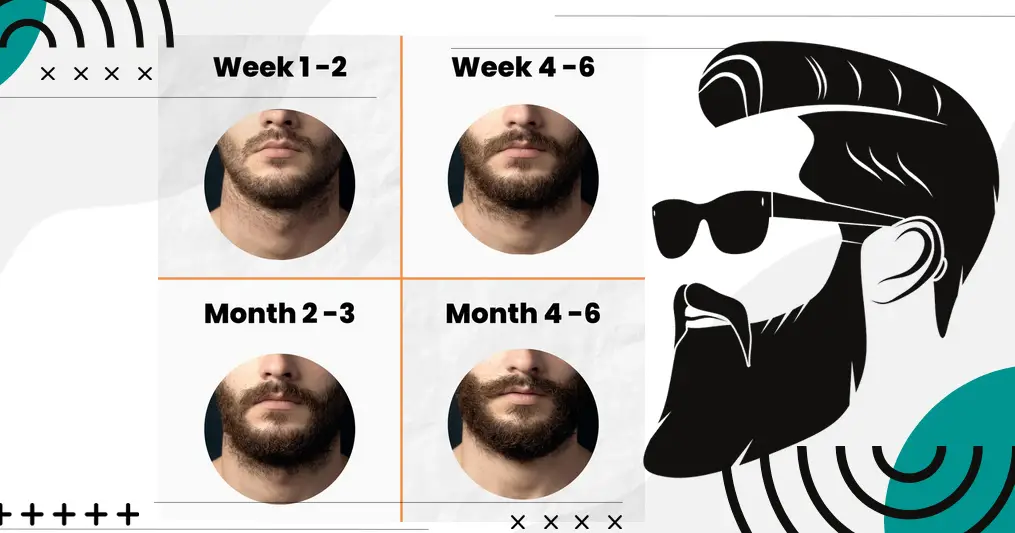
Stage 1 is the stubble phase, where facial hair becomes visible. Stage 2 marks the patchy beard stage, characterized by uneven growth. In Stage 3, the beard begins to fill in, leading to a short beard.
The following phase is about grooming and maintaining optimal growth and style until reaching Stage 5 – full-bearded glory.
https://www.youtube.com/watch?v=vkCMkH_ssXU
Stage 1: Stubble
In the first week of growth, stubble starts to make an appearance. You’ll notice light hair on your upper lip, sideburns, and jawline. Beard hair typically grows at a rate of about 1/2 inch per month, so during this stage, it’s all about cultivating the beginnings of your beard.
Using beard oils and proper care can help promote healthier growth throughout all stages.
By using products like beard oils and other essentials specifically designed for facial hair care, you can give yourself a head start in fostering healthy growth through each phase of your beard’s development.
Stage 2: Patchy
In the second stage of beard growth, also known as the “Patchy” stage, some face areas have better hair growth than others. This is when you start noticing that your facial hair is not growing evenly across all parts of your face.
It’s normal for the growth to be more robust in certain areas while appearing sparse in others due to genetic factors and individual variations in hair follicle density.
During this stage, you must remain patient as your facial hair develops. The unevenness will likely resolve over time as you progress through subsequent stages.
Stage 3: Short Beard
During the third stage, typically between weeks three and six, your beard becomes more noticeable as the hair becomes thicker. This is when you can start shaping it into a goatee or a full beard.
At this point, incorporating beard oils and other essential care products can significantly boost all stages of beard growth, promoting healthier and fuller growth.
As you move into the short beard stage, taking extra care by using appropriate maintenance products and keeping up with regular grooming routines is essential. The proper care during this phase lays the foundation for healthy and robust facial hair development in subsequent stages.
Stage 4: Growth and Grooming
After the initial stages of beard growth, like the short beard phase, comes stage 4: Growth and Grooming. This stage usually occurs between weeks 6-8 of growing your beard. During this time, it’s essential to regularly style and clean your beard to maintain its shape and keep it looking neat.
Taking care of your grooming routine at this point will help ensure that your beard grows well without any complications.
As we move into the next stage of full bearded glory, let’s talk about the factors affecting your beard growth and how to keep it healthy during these crucial weeks.
Stage 5: Full Bearded Glory
I went through the same journey and reached the pinnacle: full bearded glory. My beard thrives at its maximum potential at this stage, showcasing abundant growth and thickness.
The dedicated care I provide to my beard, including consistent washing and grooming routines, has significantly contributed to achieving this impressive milestone. Employing quality products like derma roller kits and beard growth supplements has further optimized my path to full bearded glory.
Throughout this phase, it’s essential to continue maintaining healthy habits that support robust beard growth. Regular trimming and shaping help keep my beard tidy while promoting overall health.
Factors Affecting Beard Growth
Genetics, healthy hair follicles, hormones, diet, and sleep all play a crucial role in determining the quality and growth of your beard. Understanding these factors can help you take proactive steps to support and enhance your beard growth.
Genetics
As a man, my genes significantly affect how my beard grows. If my father has a thick beard, chances are high that I will, too. Testosterone levels also affect growth – the more testosterone, the hairier I’ll likely be.
Healthy Hair Follicles
Now, let’s focus on the importance of healthy hair follicles for optimal beard growth. Healthy hair follicles are crucial in promoting longer and thicker facial hair. When these follicles are unhealthy, they can lead to dry and easily breakable beard hair.
Therefore, maintaining the health of your hair follicles is essential for achieving a fuller and healthier-looking beard.
In pursuit of a luscious beard, it’s imperative to prioritize the well-being of your hair follicles by following proper grooming practices and ensuring they receive adequate nourishment and care.
Hormones
Now, let’s talk about hormones. Testosterone, a hormone in the body, dramatically affects beard growth. The higher the testosterone levels, the more likely a person is to have thicker facial hair.
Another hormone called dihydrotestosterone (DHT) also plays a crucial role in stimulating beard growth. Genetics and age also contribute to facial hair appearing on a man’s face.
Diet
Now let’s talk about diet. A healthy diet is essential for beard growth. Eating foods rich in vitamins, protein, and minerals helps your body function well and can also impact the growth of your beard.
Ensuring you get enough sleep is also crucial for overall physical health, including beard growth, as lack of sleep can negatively affect your body’s functions.
Sleep
When it comes to beard growth, getting enough sleep is crucial. Let me emphasize that adequate and quality sleep supports the body’s physical health, including beard growth.
Lack of proper sleep can hurt the body’s functions, potentially affecting hormone levels and slowing down facial hair growth. It’s essential to understand that maintaining a healthy sleep schedule is vital in promoting optimal beard growth alongside other lifestyle choices like diet and exercise.
Conclusion
In conclusion, understanding beard growth patterns and stages is crucial for men aiming to rock full-bearded glory. Emphasize practicality and efficiency by implementing the strategies to achieve a fuller beard.
How can you apply what you’ve learned about maximizing your beard’s potential? Stress the importance of proper care and grooming in achieving a healthy, luscious beard. Consider exploring further resources or guidance for continued learning on this topic.
End with an empowering quote that encourages taking action toward nurturing your glorious facial hair!
FAQs
What are the stages of beard growth?
Beard growth happens in stages, starting with thin, soft hair called vellus and ending with thicker, fuller hair. The process goes through growing (anagen), pausing (catagen), and shedding (telogen) phases.
Why does my beard look patchy?
Patchiness can happen if your beard grows unevenly or you have areas where facial hair is thinner. Sometimes, it’s just how your hair grows, but shaping or choosing styles for patchy cheeks can help it look better.
Can I make my beard grow in one direction?
While you can’t change which way your beard hairs naturally point, trimming and using a brush might train them to lay down more smoothly.
Is the hair in my beard the same as on my head?
Nope! Beard hair is usually coarser than scalp hair because different hormones like DHT affect its growth.
How do I take care of my growing beard?
Wash your beard regularly with a good wash for beards, and use conditioner too! Also, use tools like brushes to keep it neat as it gets longer.
Why does one side of my face grow more facial hair than the other?
It’s normal for facial hair to grow more on one side than the other due to genetics or sleeping habits affecting blood flow.
What are some popular beard styles?
Beard styles have become increasingly popular in recent years. Some popular beard styles include the full beard, goatee, chinstrap, and stubble. The full beard is a classic style that covers the entire face. The goatee is a smaller beard that only covers the chin. The chinstrap is a thin line of facial hair that runs along the jawline. Stubble is a short, scruffy beard that can be trimmed to various lengths.
What are the different types of mustache styles?
There are many types of mustache styles, each with a unique look. Some popular mustache styles include the handlebar mustache, the pencil mustache, and the horseshoe mustache. The handlebar mustache is a thick, bushy mustache that curls up at the ends. The pencil mustache is a thin, narrow mustache that sits above the lip. The horseshoe mustache is a thick, curved mustache that extends down to the chin.
How do different types of facial hair textures affect grooming?
Facial hair textures can vary significantly from person to person. Some people have thick, coarse hair, while others have thin, fine hair. The texture of your facial hair can affect how you groom it. For example, if you have thick, coarse hair, you may need a more vital beard oil or balm to moisturize it. If you have thin, fine hair, you may need a lighter product to avoid weighing your hair down.
What are the different types of facial hair follicles?
Facial hair follicles can also vary from person to person. Some people have straight follicles, while others have curly or wavy follicles. The type of follicle you have can affect the way your facial hair grows. For example, if you have curly follicles, your facial hair may grow in a more erratic pattern, making it difficult to groom.
What are some short beard styles?
Short beard styles are popular for men who want a more low-maintenance look. Some famous short beard styles include the stubble beard, the chinstrap beard, and the goatee. The stubble beard is a short, scruffy beard that can be trimmed to various lengths. The chinstrap beard is a thin facial hairline along the jawline. The goatee is a smaller beard that only covers the chin.
What are some attractive facial hair styles?
Attractive facial hair styles can vary depending on personal preference and facial structure. However, some popular attractive facial hair styles include the full beard, the goatee, and the stubble beard. The full beard is a classic style that covers the entire face. The goatee is a smaller beard that only covers the chin. The stubble beard is a short, scruffy beard that can be trimmed to various lengths.
How often should I trim my beard?
The frequency of beard trimming largely depends on the style you’re aiming for and how quickly your facial hair grows. For a well-maintained look, trimming every 1-2 weeks is generally recommended. For more tips on trimming, check out our guide on Beard Trimming Tips.
What products promote facial hair growth?
Various oils, balms, and supplements can aid in facial hair growth. Products containing ingredients like castor oil, biotin, and minoxidil have been shown to promote growth. For a detailed list of effective products, visit our Best Oil for Beard Growth article.
How do I choose a style that suits me?
A facial hair style is a personal decision that should consider your face shape, lifestyle, and grooming preferences.
- AI Powered Bald Filter Online 2024: See Yourself with No Hair! - January 19, 2024
- Harklinikken Bad Reviews 2024: Analyzing Negative Feedbacks - January 18, 2024
- How to Get the Alex Eubank Hair | Step-By-Step Tutorial 2024 - January 18, 2024

